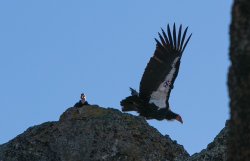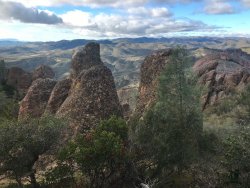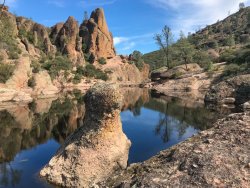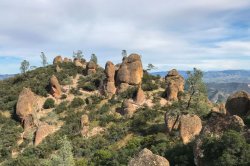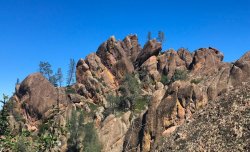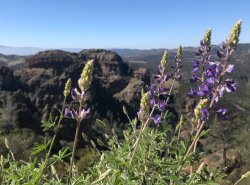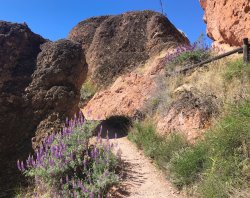- Joined
- May 24, 2015
- Messages
- 175
This relatively new National Park is located in Central California, closer to the coast than it is to the High Sierra, Pinnacles is a great day hiking destination. It remains snow free and accessible all winter. There is only one campground, located on the East side. There is no road through the park that connects the West side to the East side. There is no backpacking allowed. This report is a composite of a couple of trips made this winter. The latest was a February trip consisting of two days of day hikes from the campground side (East) that consisted of two long loops. We were able to hike almost all of the parks trails shown in the trail map below in those two days.
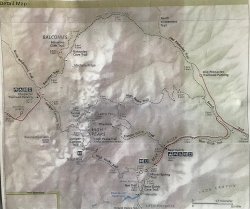
There is a fair amount of wildlife to be seen. In the quiet of the winter months sometimes bobcats can be seen hunting the ground squirrels near the vacant campsites.
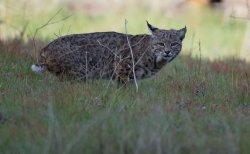
Quail , deer, turkeys and other birds are used to people and almost approachable.
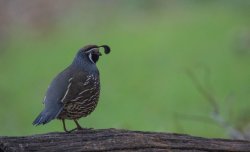

The best hikes are the trail that lead up into the pinnacles themselves. There are caved passageways thru the pinnacles that require flashlights for most of the upper trails.
Trail leading out of the Bear Gulch caves.
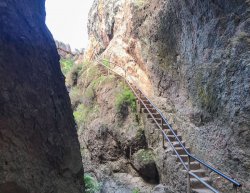
Bear gulch reservoir above the caves.
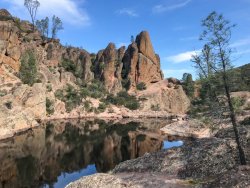
Outside of the park on the drive in there was a Golden Eagle perched above the road.
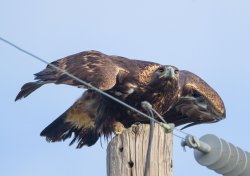
He later landed in a more natural setting.
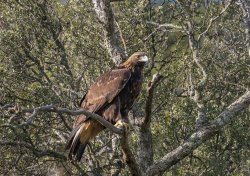
A smaller hawk was also cruising the ranch lands outside of the park.
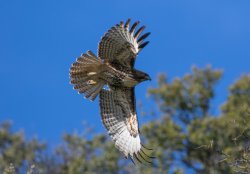
I hiked the best trails in one weekend with my buddy Russ. It was late February but there were already flowers blooming sporadically along the trail.
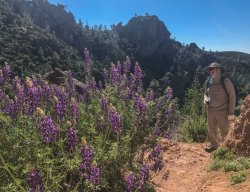
We saw this rock that looked to us like a whale surfacing. Plankton anybody?
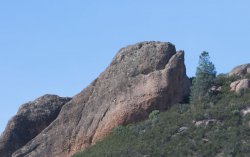
The trail is quite impressive, taking you right up into the distant Pinnacles.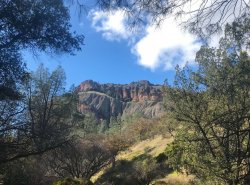
To get there we had to crawl under some narrow areas. I was glad we only had daypacks on.
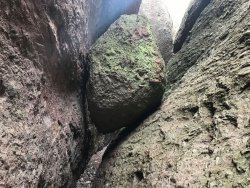
The scenery started to get pretty impressive higher up.
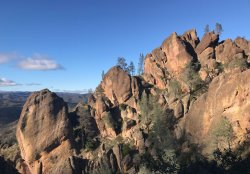
There are lots of climbing opportunities and we started to see more climbers as the weekend approached. Prior to that we started to see the other well known Pinnacles residents, the California Condor.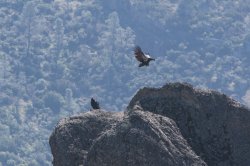
Their populations are still recovering from the presence of too much lead ammunition being used by hunters. Pinnacles is a common release point for many of the captive raised birds so it is a good place to see North Americas largest bird in the wild. Green 700 from Boise below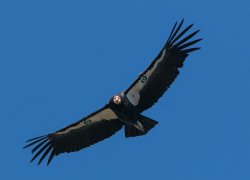
They are almost all tagged and it was fun to identify them by colored tag and then later look them up online to read about their life stories and personalities. From up high we could see some of them perched on distant pinnacles and occasionally they would fly below us.
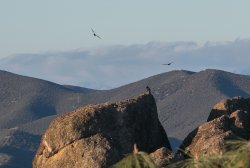
The highest part of the trail uses a series of handrails and rock stairs.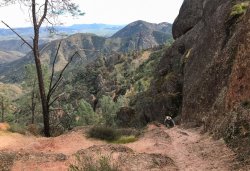
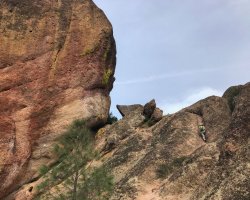
We had lunch at the top and visited with a condor biologist. Condor 78 was named Electra and is known as a dominant female. In this picture I believe you can faintly see part off the birds retracted red neck thru the breast feathers.
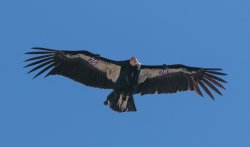
Some other birds were perched around us also. Scrub Jay
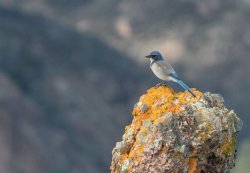
Oak Titmouse
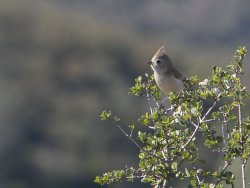
There was a lot of good scenery up high.
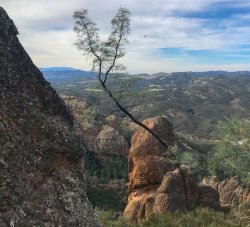
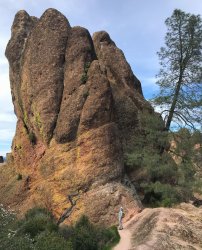
Then we headed down.
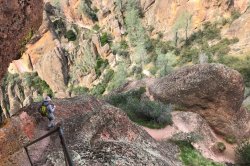
The lower parts of the trail run along shaded creeks.
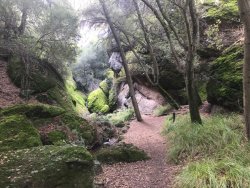
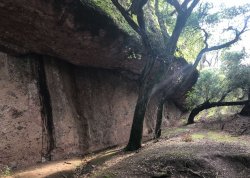
Early flowers and shaded shrooms.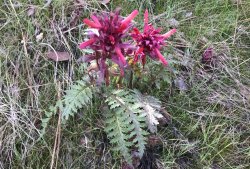
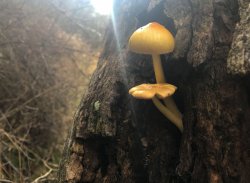
West side trail head.
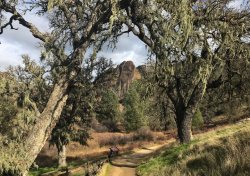
On the drive out of the park we saw these Yellow Billed Magpies. They only live in Californias Central valley. Bird folks sometimes drive a long way to see them.
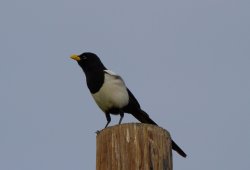
Thanks for watching.

There is a fair amount of wildlife to be seen. In the quiet of the winter months sometimes bobcats can be seen hunting the ground squirrels near the vacant campsites.

Quail , deer, turkeys and other birds are used to people and almost approachable.


The best hikes are the trail that lead up into the pinnacles themselves. There are caved passageways thru the pinnacles that require flashlights for most of the upper trails.
Trail leading out of the Bear Gulch caves.

Bear gulch reservoir above the caves.

Outside of the park on the drive in there was a Golden Eagle perched above the road.

He later landed in a more natural setting.

A smaller hawk was also cruising the ranch lands outside of the park.

I hiked the best trails in one weekend with my buddy Russ. It was late February but there were already flowers blooming sporadically along the trail.

We saw this rock that looked to us like a whale surfacing. Plankton anybody?

The trail is quite impressive, taking you right up into the distant Pinnacles.

To get there we had to crawl under some narrow areas. I was glad we only had daypacks on.

The scenery started to get pretty impressive higher up.

There are lots of climbing opportunities and we started to see more climbers as the weekend approached. Prior to that we started to see the other well known Pinnacles residents, the California Condor.

Their populations are still recovering from the presence of too much lead ammunition being used by hunters. Pinnacles is a common release point for many of the captive raised birds so it is a good place to see North Americas largest bird in the wild. Green 700 from Boise below

They are almost all tagged and it was fun to identify them by colored tag and then later look them up online to read about their life stories and personalities. From up high we could see some of them perched on distant pinnacles and occasionally they would fly below us.

The highest part of the trail uses a series of handrails and rock stairs.


We had lunch at the top and visited with a condor biologist. Condor 78 was named Electra and is known as a dominant female. In this picture I believe you can faintly see part off the birds retracted red neck thru the breast feathers.

Some other birds were perched around us also. Scrub Jay

Oak Titmouse

There was a lot of good scenery up high.


Then we headed down.

The lower parts of the trail run along shaded creeks.


Early flowers and shaded shrooms.


West side trail head.

On the drive out of the park we saw these Yellow Billed Magpies. They only live in Californias Central valley. Bird folks sometimes drive a long way to see them.

Thanks for watching.
Attachments
Last edited:

